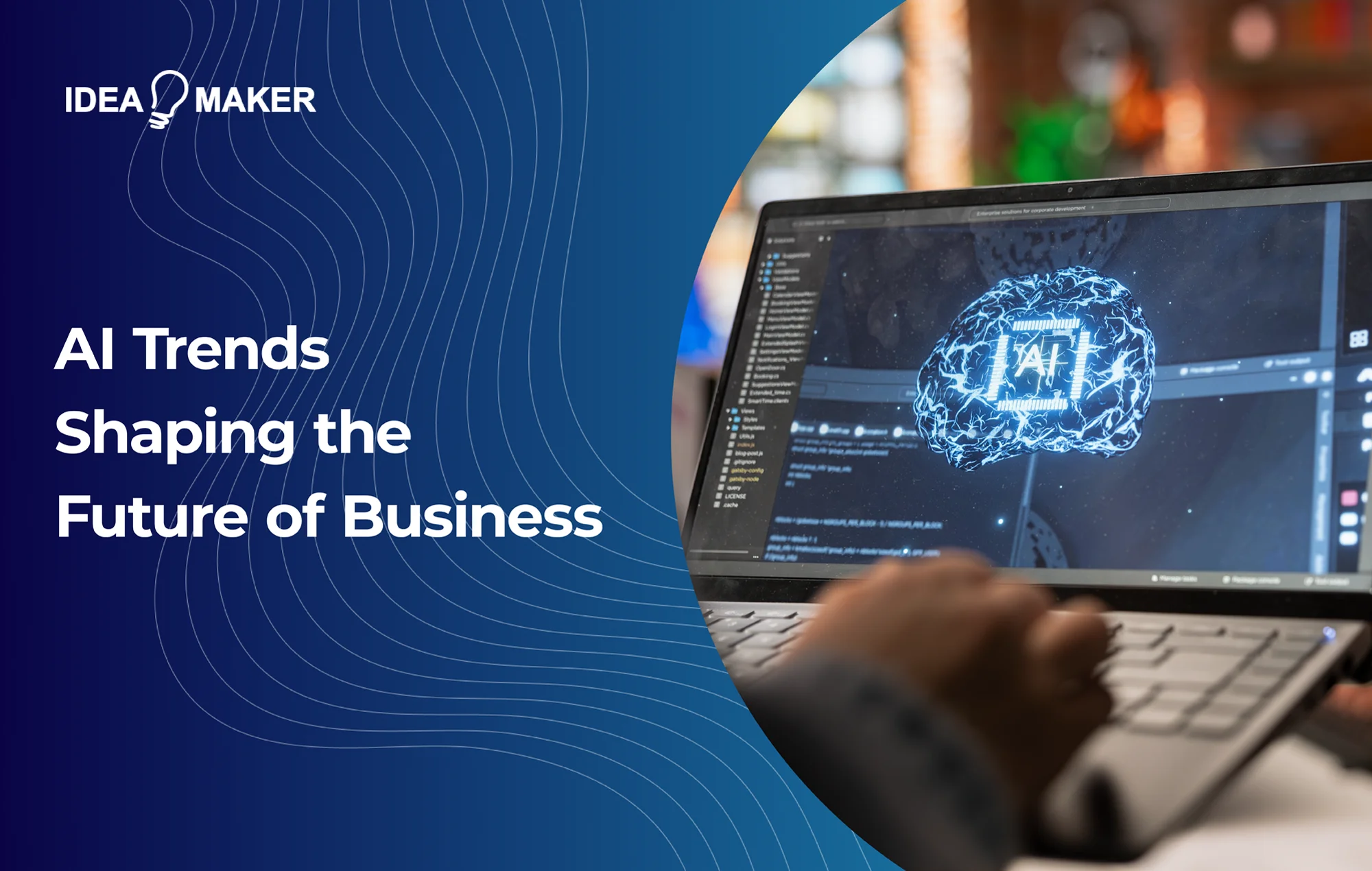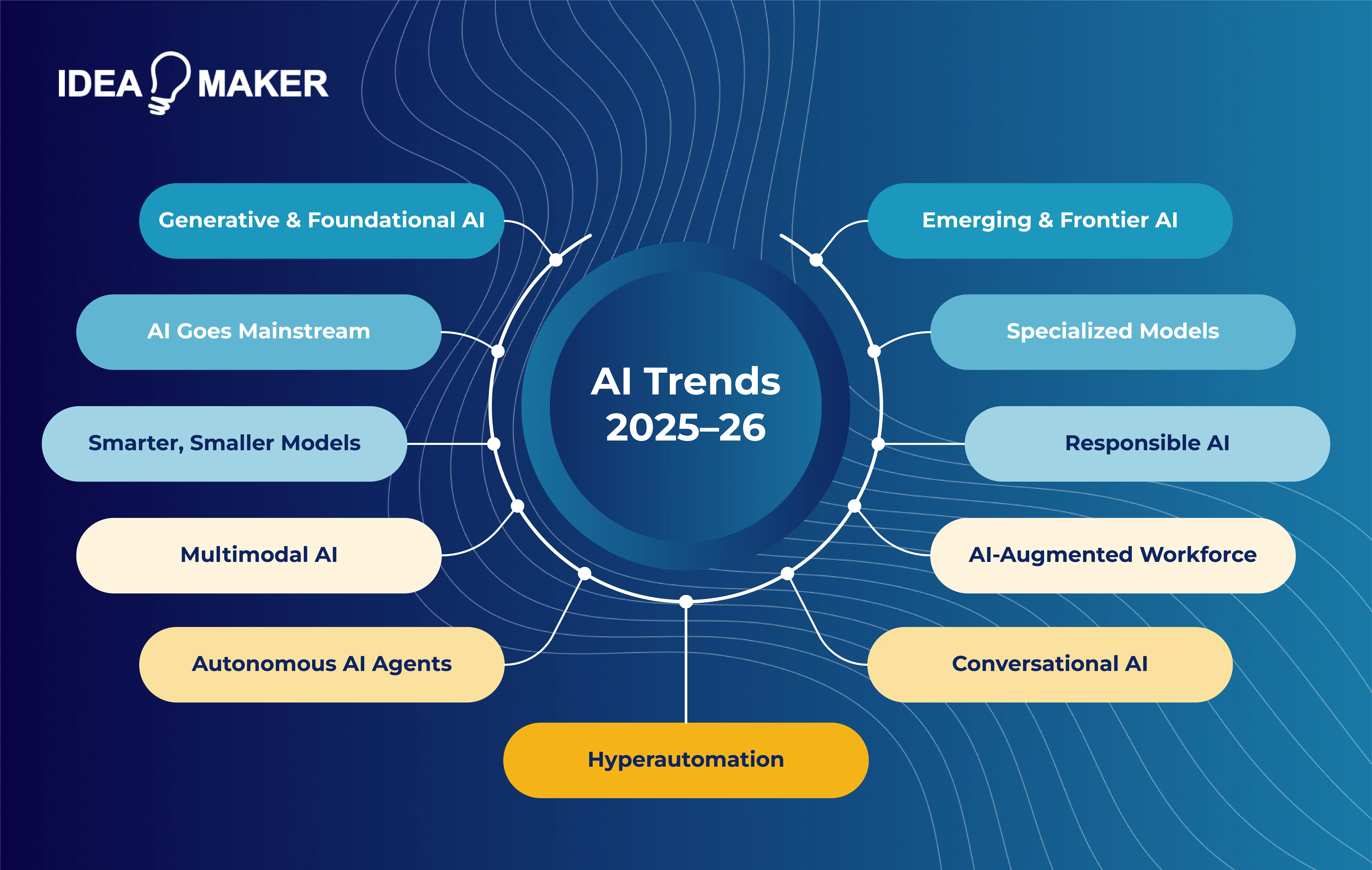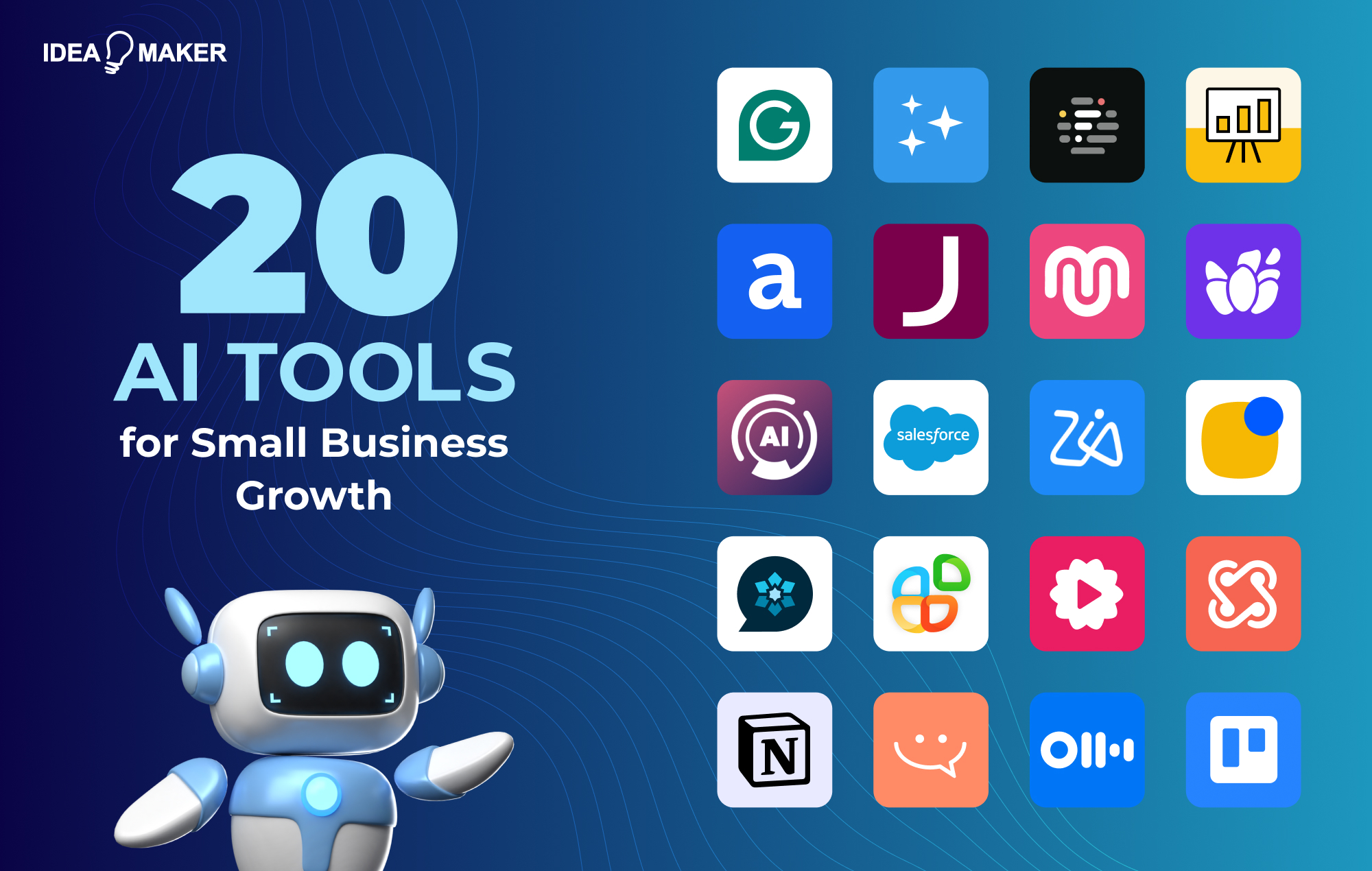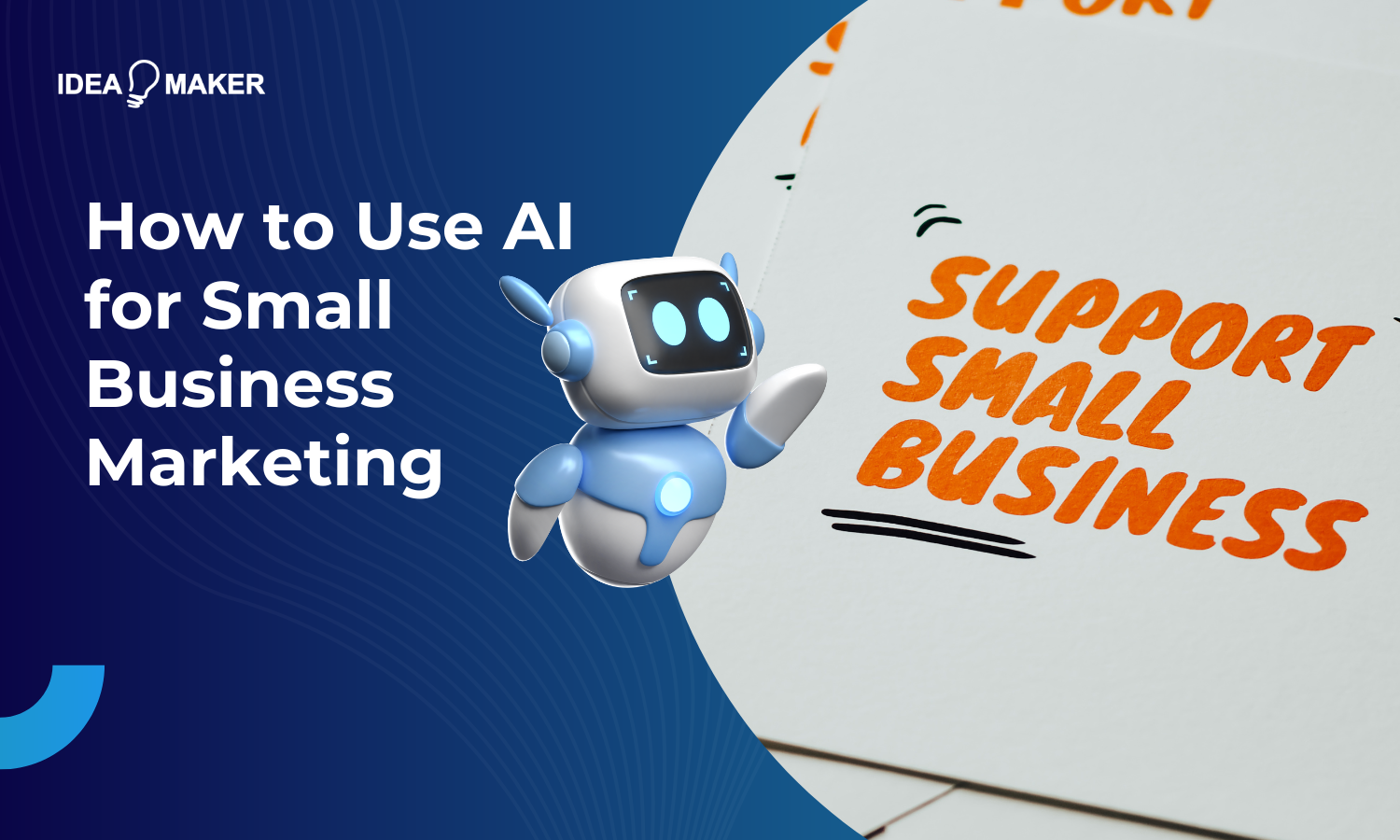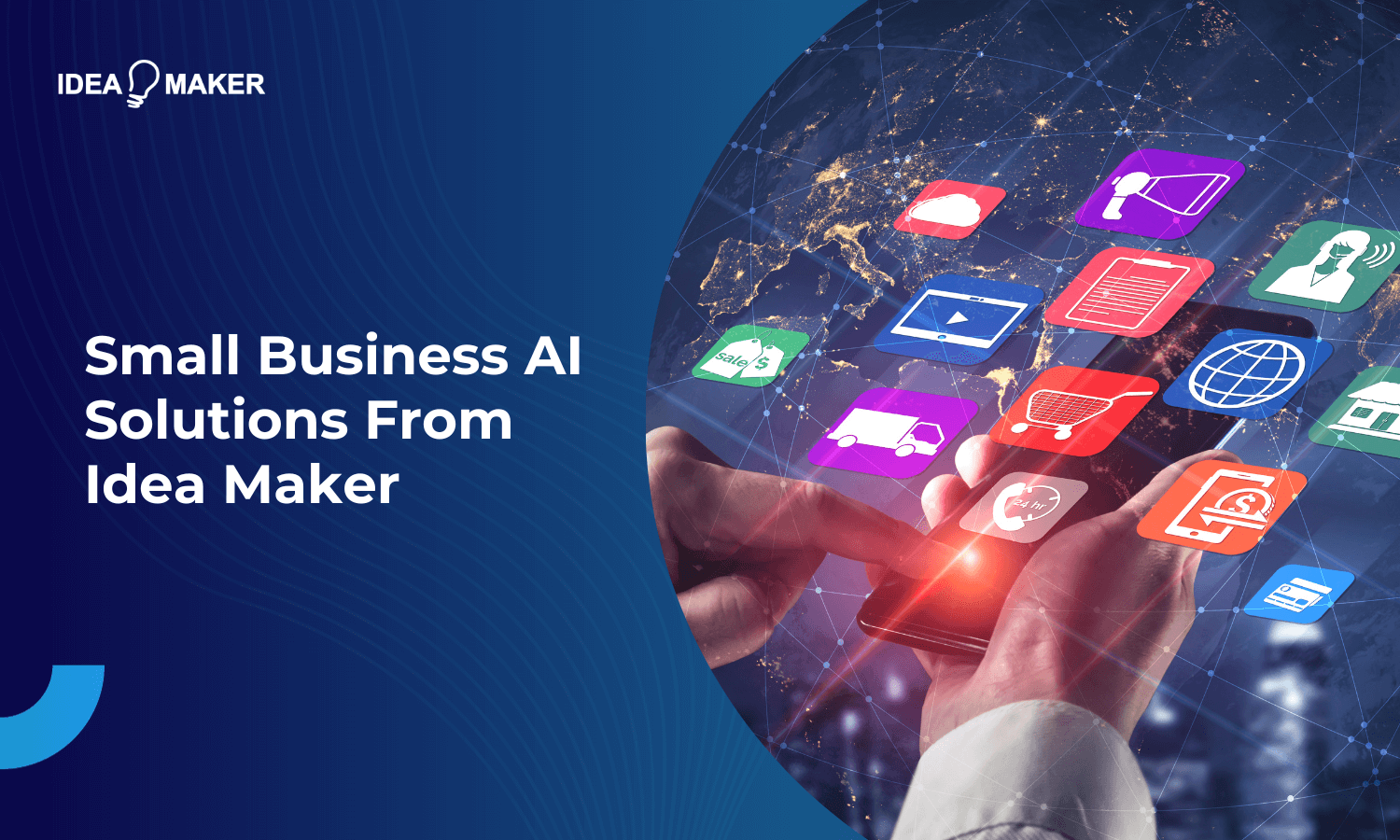The age of AI is no longer on the horizon. It’s here and moving faster than anyone anticipated. Since the first public OpenAI models launched in 2019, artificial intelligence has made some major breakthroughs with systems now capable of reasoning, generating, and automating at levels once thought impossible. Businesses are now no longer just experimenting with AI, they’re rethinking entire operations around it.
To help you navigate what’s ahead, Idea Maker has compiled the most recent AI trends of 2025 and into 2026. You will see how generative systems, agentic workflows, and industry-specific models translate into real outcomes. From customer experience to operations, this guide shows what works in practice and how early adopters turn momentum into durable advantage. Ready to see where AI can take your business next?
Table of Contents
Why AI Trends Matter to Business Leaders
AI trends are not just tech signals, they’re directional markers for where value is shifting and where competitors are quietly gaining ground. McKinsey reports 78% of organizations now use AI in at least one function. Companies acting on the latest AI advancements aren’t chasing hype, they’re locking in faster cycles, better margins, and stronger data moats while everyone else watches.
Just take this study as an example. Bain reports that 95% of U.S. companies now use generative AI, with production use cases doubling year over year. Yet most still haven’t operationalized it. Gartner predicts over 80% of enterprises will be using GenAI tools by 2026, but only a fraction will have clear metrics, working governance, or meaningful ROI.
That gap is where leadership matters. Being early isn’t about being first, but rather turning emerging trends in artificial intelligence into a repeatable advantage. It’s also about knowing what to build, what to buy, and what to leave alone. IBM’s 2025 research found that just 1% of enterprise data has been tapped for AI. The opportunity is already inside the business, waiting on structure, clarity, and execution.
For leaders, this only means one thing: lean in early into AI and compound your gains, or sit on the sidelines and watch the gap widen. AI trends help business owners make those calls. They offer a lens into what’s viable now, what’s worth piloting, and where the payoff is measurable. The companies that pay attention to these shifts don’t just adapt, they set the pace for everyone else to follow.
Top AI Trends to Watch
1. Generative & Foundational AI
Generative AI is quickly becoming a part of everyday work across major industries and corporations. Microsoft reports that 75% of knowledge workers use AI, Canva’s features were used more than 10 billion times last year, and 15 million developers now work with GitHub Copilot. This scale of adoption means AI is moving from novelty to workflow. Teams will soon expect AI tools to deliver measurable outcomes in revenue, cost, and risk optimization.
AI-first platforms are scaling rapidly too. Cursor raised $900 million at a $10 billion valuation and already reached $100 million in recurring revenue. This shows that products built around AI are attracting strong market demand.
Foundation models have become the infrastructure layer for enterprises. Nearly 90% of notable 2024 models came from industry, and almost 65.7% of new models in 2023 were open source. This marks a shift toward open models as a deliberate choice for flexibility, cost control, and customization. Many organizations will run hybrid stacks that use proprietary models for sensitive or latency-critical work, and open models where portability and governance matter most.
Architecture and UX are also evolving together as per latest developments in AI. Retrieval-augmented generation is moving into mainstream adoption, with 29% of enterprises implementing it. Context windows have expanded from Claude Sonnet 4’s 200,000 tokens to Google Gemini 1.5 Pro’s 2 million. Larger windows help, but the real gains come from high-quality retrieval, structured planning, and continuous evaluation to reduce hallucinations.
UX is also becoming more dynamic with Generative UI, where interfaces are built in real time. Vercel’s AI SDK can stream buttons, forms, and layouts based on user intent. This shift requires strong guardrails, including fallback states, interaction contracts, and audit logs, so dynamic interfaces remain trustworthy and testable.
2. AI Goes Mainstream
Artificial Intelligence has moved from pilots to the operational core. McKinsey’s early 2025 survey shows adoption at 78% from just 55% in 2023. IDC expects global AI spending to reach 632 billion dollars by 2028. The speed of this jump tells us that the early hesitation is gone. Executives are no longer asking if AI should be used, but where it will have the fastest and most significant return.
Healthcare shows how quickly the change is taking hold. The FDA has approved more than 1,000 AI-enabled devices covering radiology, cardiology, and clinical decision support. The competitive edge here will come from hospitals and clinics that can integrate these tools without slowing down care delivery. Those who blend regulatory compliance with operational efficiency will set the pace for the rest of the sector.
Transportation is pushing beyond trials. Waymo has logged over 100 million fully driverless miles and runs about 1,500 vehicles in major U.S. cities. The bigger story is not just scale, but the industry’s pivot from proving autonomy works to proving it can be profitable. That will hinge on lowering operating costs, securing city-level approvals, and convincing a cautious public to trust a driverless service.
Enterprise software is embedding AI into core workflows. Google’s Gemini for Workspace and Salesforce’s Einstein 1 Studio bring generative tools into everyday apps. Once employees adapt to this level of built-in intelligence, platforms without it will feel outdated. As a result, more and more vendors will be forced to rethink product roadmaps around AI as a default feature.
Industry leaders see a structural change underway. NVIDIA’s Jensen Huang predicts companies will operate “two factories.” One for the product and one for the AI that designs and runs it. That mindset is fueling a wave of hyperautomation. Those that succeed will treat AI as a core operating layer, using it to accelerate decision-making and execution across the business.
3. Smarter and Smaller: Efficient AI Models
Latest AI developments in 2025 suggest an inclination toward models that are intentionally smaller, faster, and purpose-built. Microsoft’s Phi-3 is a prime example. A 3.8B-parameter model trained on 3.3T tokens can run on a phone yet rival much larger systems on common benchmarks. Google’s Gemma 2 line follows the same path with 2B, 9B, and 27B open models that deliver strong results without heavy infrastructure. For many enterprises, this is less about chasing leaderboard scores and more about right-sizing AI so it meets performance needs without creating hardware or cloud cost burdens.
Edge computing is also gaining serious AI horsepower. Apple’s M4 Neural Engine delivers up to 38 TOPS in the latest iPad Pro, enabling on-device generative features. Qualcomm’s Snapdragon platforms now run large models directly on PCs and phones, with the X Elite NPU at 45 TOPS and over 2 billion products shipped featuring the Qualcomm AI Engine. Running inference close to the user cuts latency, keeps data local for privacy, and allows uninterrupted functionality even without internet. This is key for regulated industries, field operations, and mission-critical applications.
Under the hood, AI developments in efficiency are coming from compression and modular designs. QLoRA proved that a 65B-parameter model can be fine-tuned on a single 48 GB GPU, turning customization into a short project instead of a major capital investment. Sparse Mixture-of-Experts designs, like Mistral’s Mixtral line, activate only part of the model per token, delivering large-model quality at mid-model costs. This signals a maturing engineering mindset where adaptability and targeted capability are prioritized over chasing maximum size.
Access is also broadening fast according to the most recent AI developments. The Hugging Face Hub now hosts more than 1.7 million models, putting high-quality open weights, tools, and evaluation frameworks just a few clicks away. Combined with lighter architectures and edge-ready acceleration, this access is transforming AI from a data-center project into something deployable inside an app, a sensor, or a workflow module.
4. Multimodal and Cross-Input Intelligence
AI is learning to work the way people do. Leading models such as OpenAI’s GPT-4o now process voice and vision in real time, while Google’s Gemini 2.5 is built for native multimodality across text, images, video, audio, and code. This shift means people can move from describing a problem to showing it, giving AI richer context for faster and more accurate responses.
In the enterprise world, assistants are evolving into searchable knowledge layers that cut down on the constant back-and-forth of information hunting. Microsoft 365 Copilot Search can now pull answers from across Microsoft apps and connected external systems, making questions like “what did we decide?” or “where is the file?” a single prompt. For organizations with large content repositories, this can change how decisions are made, reducing delays caused by missing or fragmented information.
Cross-sensor intelligence is moving quickly from prototypes to production. Waymo’s sixth-generation driver fuses 13 cameras, 4 LIDAR, 6 radar, and audio receivers to perceive complex city scenes. Apple Vision Pro blends cameras, LiDAR, eye tracking, and motion sensors to map spaces and track movement in real time. The benefit is not just richer perception, but the ability for systems to anticipate outcomes, which has significant implications for autonomy, predictive maintenance, and real-world training.
Demis Hassabis has said the goal is an AI that understands the world “through all our senses.” That vision is becoming achievable. A well-designed multimodal assistant could listen to a meeting, interpret a whiteboard image, and instantly retrieve the right contract. For leaders, the takeaway is clear: multimodality is not a niche capability. It is becoming a foundation for tools that work naturally with the way people communicate and process information.
5. Autonomous AI Agents & Decision Systems
One of the most important AI developments of 2025 is the shift of Agentic AI from demos to everyday operational use. These agents plan steps, call tools, act on records, and close loops inside enterprise systems. Salesforce’s Engine cut average case-handling time by 15 percent, while 1-800Accountant resolved the majority of admin chats during peak tax weeks. These gains reflect a broader change about how businesses are starting to trust AI agents with front-line responsibilities that directly affect revenue and customer retention.
Department copilots are also evolving into active operators. In finance, Microsoft’s Copilot for Finance works directly inside Excel, Outlook, and Teams to surface anomalies, assist with variance analysis, and recommend collections actions. Embedding decision-making capabilities within the tools employees already use is what turns AI from an occasional assistant into a constant operational partner.
In HR and finance, agent cohorts are taking on structured workloads. Workday’s Illuminate Agents and Oracle’s AI Agent Studio both focus on scaling routine tasks while enforcing governance. The next competitive edge won’t just be in deploying agents, but in managing them like a workforce with clear accountability, defined scopes, and performance tracking.
Legal services also hint at where this is heading. Reports show top U.S. law firms now use Harvey for more complex work beyond drafting. If industries with high regulatory and reputational stakes can entrust agents with nuanced decisions, it signals that the model is ready for broader, cross-sector adoption.
For leaders, the challenge is designing the right operating model. Give agents the authority and resources to act, but pair them with human oversight for high-risk steps. When autonomy is balanced with governance, AI agents shift from being experimental add-ons to dependable, scalable units of work. And that’s when they start to reshape entire business processes.
6. AI-Powered Automation & Hyperautomation
Hyperautomation has shifted from theory to operating model according to the latest trends in AI. Gartner defines it as a structured approach to identifying and automating as many business and IT processes as possible, using AI, RPA, BPM, and integration platforms together. The aim is no longer to speed up individual tasks, but to connect entire process chains across finance, HR, operations, and customer service. When implemented well, this creates a continuous flow of work with fewer manual checkpoints and less operational drift between departments.
Vendors are embedding automation into the software ecosystems companies already rely on. Automation Anywhere offers native connectors for SAP, Salesforce, Workday, and other SaaS platforms, while iPaaS providers like Workato deliver SAP RFC and Oracle E-Business Suite connectors that coordinate cross-application workflows without manual integration builds. These ready-made pathways allow automation to plug into high value transactions directly, avoiding the lag and cost of custom middleware projects.
Optimization is also becoming evidence-driven. Process and task mining, paired with AI, expose bottlenecks and leakage points before teams automate the wrong steps in their workflow. Celonis reports 89 percent of executives believe AI without process intelligence fails to deliver on expectations. By starting with this visibility, leaders can focus automation on steps that truly affect speed, cost, and service quality instead of simply making existing inefficiencies faster.
For leaders, the opportunity is to treat automation as an operational framework, not just a set of tools. Integration at the ERP or CRM level keeps data in its native environment. Pairing this with process intelligence directs investment toward changes that cut cycle time, lower error rates, and reduce service costs. When approached this way, automation becomes part of the company’s core operating rhythm.
7. Conversational AI & Customer Experience
Conversational AI has become the default entry point for customer service, with humans now handling the complex or high-stakes exceptions. Deloitte’s 2025 contact-centre survey shows a 15 percent jump in AI adoption between 2023 and 2025. Yet the same study warns CX scores drop when bots lack contextual intelligence. The real competitive factor is orchestration that blends speed with accurate understanding.
That orchestration now stretches beyond troubleshooting. Conversational AI is moving higher up the revenue stack, qualifying leads, nurturing prospects, and guiding product onboarding. Forrester projects generative AI will displace 100,000 frontline agents at the largest outsourcers by 2025. This will happen through automation of low-complexity sales and service flows, not full replacement. The human role is shifting toward higher-value interactions where persuasion, empathy, and negotiation have greater impact.
Customer behavior is adapting in parallel. When speed is the priority, many now go straight to bots. Zendesk reports 51% of consumers prefer bots for immediate service. The resulting model is “AI-first, human-in-the-loop,” where automation sets the pace and human intervention preserves quality. This is emerging not only in support, but also in onboarding and early-stage sales qualification.
Personalization is deepening through real-time sentiment and intent analysis. Emotion-sensitive LLMs have been shown to raise perceived competence and trust in service interactions, even when resolution rates remain constant. Zendesk’s latest Total Economic Impact study supports this. AI resolves 10 percent of inquiries in year one and 30 percent by year three without human intervention. For leaders, this offers a way to scale service while keeping satisfaction stable. That balance has been difficult to achieve in past automation cycles.
The economics are compelling. Gartner projects conversational AI will cut contact-center labor costs by roughly $80 billion in 2026. As these systems mature, expect them to anchor sales, marketing, and onboarding flows. They will handle high-volume groundwork and flag the exact moments when human judgment is required.
8. AI-Augmented Workforces
The center of gravity has shifted from “AI will replace jobs” to “AI is upgrading how people work.” Slack’s Workforce Lab reports 60% of workers now use AI at work, with daily usage up 233% since late 2024. Adoption is largely employee-led, as assistants embed themselves into documents, email, meetings, and analysis without waiting for top-down mandates.
In practice, companies are standardizing on human-in-the-loop designs. Agents draft, rank options, and execute routine steps. People review exceptions and decisions that carry risk. This division is now reinforced by regulation. The EU AI Act requires human oversight for high-risk uses, while NIST’s AI Risk Management Framework advises building approvals, monitoring, and controls directly into workflows.
Productivity gains are measurable when augmentation is done well. A controlled experiment found developers completed a coding task 55 percent faster with GitHub Copilot. A large field study of 5,000 customer-support agents showed a 14 percent lift in issues resolved per hour. Notably, the biggest improvements came from less-experienced workers, suggesting AI can help close skill gaps while boosting output.
Roles are evolving rather than disappearing. The World Economic Forum’s 2025 report highlights rising demand for analytical thinking, AI and big data skills, and technology literacy. It also notes that two-fifths of current skill sets will change by 2030. This is why reskilling has moved from a training department function to a board-level priority.
A new delivery model is emerging as well. Providers are beginning to sell outcomes performed by AI agents instead of software seats. Investors and operators often call this Service-as-a-Software or Reverse SaaS. Vertical platforms are taking on workflows once too complex for automation, shifting from “we give you the tools” to “we do it for you.”
For leaders, the playbook is to pair people with agents and define handoffs step by step. Add checkpoints for high-risk actions. Keep audit logs by default. Set clear tool permissions. When managed this way, AI becomes an operating layer that compounds its impact across teams over time.
9. Ethical, Responsible, and Regulated AI
One of the key emerging trends in AI is the movement of artificial intelligence governance from principles to implementation. In Europe, the AI Act is now in force, with rules phasing in through 2026. That means bans on certain uses are already live, and most high-risk systems will need to meet strict requirements before they hit the market. For companies, this isn’t something to leave for “later.” Building for compliance from day one will save months of retrofitting when deadlines arrive.
In the U.S., NIST’s AI Risk Management Framework and Generative AI Profile give practical guardrails for teams, while ISO/IEC 42001 adds a way to formalize them into a certifiable program. Think of it as the difference between “following good advice” and “having proof you followed it.” This shift will make governance not just a legal necessity, but a selling point when working with partners and clients.
Risk management is also becoming a design feature, not an afterthought. The NIST GenAI Profile highlights techniques like retrieval-augmented generation, safety testing, and continuous monitoring to reduce bias, hallucinations, and misuse. Teams that bake these safeguards into the build process will avoid costly fixes and keep trust intact when the system scales.
There’s also a bigger push for trust in what AI creates. Tools like Google DeepMind’s SynthID and the C2PA “Content Credentials” standard can prove where content came from and whether it’s been altered. With deepfakes and synthetic media on the rise, these markers will become part of how audiences decide who to believe.
These latest developments in AI open new markets. In healthcare, the FDA is allowing adaptive models to update safely under new guidance as long as they’re monitored after release. This is creating a market for continuous compliance services, where monitoring and validation aren’t just for safety, but also for staying competitive in regulated industries.
10. Specialized, Small, and Vertical Models
Enterprises are moving away from one-size-fits-all toward models designed for the language, processes, and regulations of specific industries. Finance has BloombergGPT, a 50 billion parameter system trained on financial corporations. Google is packaging vertical families such as MedLM for healthcare and Sec-PaLM for cybersecurity to meet regulated workflow needs. Such specialized models often succeed not because they are more “powerful” in a generic sense, but because they remove the guesswork in high-stakes fields where accuracy and compliance outweigh raw versatility.
Small language models are also gaining momentum because they reduce costs and keep inference close to where data lives. Microsoft’s Phi-3 Mini runs on a phone-class device while competing with larger systems on benchmarks. Apple’s on-device and server foundation models point to the same approach for privacy-sensitive workloads. In practice, smaller models are giving organizations more control over their data, faster response times, and fewer external dependencies. They are becoming a strategic choice for companies that value autonomy as much as performance.
Architectural improvements are adding further efficiency. Mixture-of-Experts activates only a fraction of parameters per token, giving high capacity without paying full compute costs. Google’s Switch Transformers set an early standard for scaling this approach. These designs make it realistic to use advanced AI in time-critical applications like fraud prevention, industrial monitoring, or adaptive training without burning through infrastructure budgets.
Open-weight models are now a credible first choice when flexibility and governance are priorities. Meta’s Llama 3 family delivers state-of-the-art results with permissive licenses, and independent leaderboards show open models closing the gap on multiple fronts. For leaders, the most competitive strategies will not hinge on a single model. They will mix vertical expertise, efficiency gains from small or MoE models, and the control offered by open weights to build AI portfolios that evolve alongside the business.
11. Emerging & Frontier AI Technologies
Shadow AI has gone from a quiet IT concern to a board-level priority. An October 2024 Software AG study found that about half of employees use unapproved AI tools and many would keep doing so even if banned. Zluri’s 2025 workplace report adds that four out of five AI apps in enterprises run unmanaged. This shows that adoption is happening faster than governance can keep up. Leaders need policies that make approved tools just as useful as the shadow ones employees already rely on, or risk losing visibility into critical workflows.
Quantum computing is advancing through targeted pilots rather than sweeping breakthroughs. Researchers have demonstrated “quantum utility” on noisy machines using error-mitigation techniques, while IBM and Moderna applied quantum simulation to predict the structure of a 60-nucleotide mRNA sequence. The strategic move now is to pick specific problems that could gain an edge from quantum and run short, contained experiments. Organizations that develop in-house familiarity today will be positioned to move faster than competitors when the hardware catches up.
Digital twins are also moving from innovation showcases to operational tools. BMW runs factory-scale twins on NVIDIA Omniverse, simulating layouts, robotics, and logistics before construction begins. The real step change comes when these twins are linked to live operational data, enabling them to alert teams to inefficiencies or safety risks before they escalate. McKinsey estimates this market could reach $73.5 billion by 2027, putting adoption firmly on an upward curve.
Latest advancements in AI are allowing analytics to shift from static dashboards to systems that recommend and execute actions. Gartner forecasts that by 2027, 75% of new analytics content will be contextualized by generative AI. This will reshape the analyst’s role into one that curates decision flows, with AI surfacing the insight and triggering the next step in the same environment.
Industry-Specific AI Trends
Healthcare
AI adoption in healthcare is now moving past isolated pilots into routine practice. A July 2025 Radiology paper reports that around 30% of U.S. radiologists and practices use AI, particularly for report generation and workflow support. A JAMIA survey of 43 U.S. health systems found imaging and radiology to be the most widely deployed clinical AI use case, partially or fully active in 90% of organizations. This concentration isn’t surprising. Radiology offers structured, high-volume data that pairs well with computer vision and natural language generation models, making it a natural entry point before spreading into more complex specialties.
Patient engagement is shifting from static portals to active, AI-driven assistance. An April 2025 MGMA poll found that roughly one in five U.S. medical group practices already use chatbots or virtual assistants for patient communication. A 2025 JMIR Cancer study on a personal virtual assistant for post-operative oncology patients showed high acceptance and consistent use for medication and exercise reminders. These tools rely on conversational AI and context-aware scheduling algorithms, proving that when systems integrate naturally into patient routines, adherence improves without adding workload to staff. For providers, this means engagement strategies can evolve from reactive responses to proactive health management.
Operational AI is becoming predictive rather than just reactive. Hospitals are deploying models that forecast readmissions, bed demand, and discharge timing. Recent studies confirm that community settings can accurately predict 30-day readmissions using routinely collected data, often with gradient-boosting models and recurrent neural networks. When these forecasts feed into daily huddles and scheduling, the result is fewer last-minute staffing issues and better allocation of high-acuity resources. For health systems under constant cost and capacity pressure, this is the difference between firefighting and running a controlled operation.
Retail
Retailers are shifting from pilots to pervasive AI, with personalization now tied to real revenue goals. McKinsey’s 2025 guidance highlights deeper use of first-party data and real-time orchestration among new developments in AI, allowing recommendations to feel consistent both in-store and online. This shift shows that personalization is now a retail standard, not an experiment. AI is being woven into pricing, promotions, and product placement to actively drive margin growth.
On the floor, computer vision is becoming part of daily operations. Amazon’s Just Walk Out and Carrefour’s EdgeSense pilots show how automated shelf tracking and planogram compliance are gaining traction. These systems teach stores to “see” inventory in real time, turning restocking from reactive to predictive and reducing missed sales in fast-moving categories.
Customer experience is also getting more context-aware. Gartner ranks it among the highest-impact AI use cases in service. Combined with natural language understanding, it allows frontline staff to adapt tone, timing, and offers in a way that feels personal rather than scripted. Trials in facial recognition for loss prevention and VIP service are growing, but so are privacy concerns. Retailers that adopt these tools with clear consent will balance trust with the speed and precision AI can deliver.
Finance
AI is now embedded across the financial stack. Supervisors in Europe report active use in fraud detection and AML surveillance to credit scoring and risk modeling. Deployment spans banking, insurance, and asset management, touching both client-facing services and back-office operations. What was once a series of experimental pilots is now part of the infrastructure that keeps transactions secure, compliant, and competitive.
Markets are increasingly relying on AI for trade execution, investment research, and compliance monitoring as per IOSCO. Reuters reports large banks are introducing firmwide AI assistants to support relationship managers, while wealth platforms test client-facing copilots. These tools bring real-time analysis and market insights directly into decision-making workflows, reducing lag between market movement and client action.
Operations are the next frontier as per the latest developments in AI. Banks are combining robotic process automation (RPA) with machine learning to speed KYC checks, reconciliations, and reporting. The result is fewer bottlenecks, faster onboarding, and a leaner cost structure, all of which are key advantages in a sector where margins are already under constant pressure.
Regulators remain focused on model and concentration risks, signaling that AI adoption must grow alongside robust governance frameworks. Those who balance speed with control will be the ones to sustain AI’s gains in finance.
Manufacturing
Factories are wiring AI into daily decision-making. Predictive maintenance and vision-based defect detection are moving from pilots to standard practice, driven by the high cost of unplanned downtime. With unexpected equipment failures costing large firms up to $1.4 trillion annually, AI-powered inspections and prescriptive upkeep are becoming critical safeguards against cascading outages. These systems no longer just alert engineers. They recommend specific fixes and schedule them into existing workflows, keeping production momentum intact.
On the line, robotics is getting smarter rather than just bigger. Collaborative robots now make up about one in ten industrial robot installations worldwide, reflecting a pivot to human-robot teams for flexible tasks and quality checks. Pairing these robots with continuous vision systems means defects are caught in real time, protecting both product yield and brand reputation.
The latest advancements in AI are also keeping supply chains “always on.” Real-time analytics now adjust inventory, routing, and capacity in response to live conditions, replacing static planning cycles. When combined with digital twins like BMW’s Virtual Factory, manufacturers can test layouts, robotics, and flows before physical rollout, then feed performance data back into the model. This creates a closed loop where every production run makes the next one smarter.
Science & Biotech
Emerging trends in AI show how discovery is accelerating from target finding to trial design. A 2025 Nature Medicine review highlights its growing role in hit discovery, toxicity prediction, and clinical decision support. In genomics, AlphaFold 3 expanded beyond proteins to model DNA, RNA, ligands, and ions with large accuracy gains. This makes early-stage research far less dependent on slow and costly lab work, allowing teams to explore a broader range of candidates before committing resources.
Labs are becoming more automated and data native. “Self-driving labs” integrate robotics with active-learning models to run experiments with minimal human input. This not only accelerates research cycles but also reduces material waste, which can lower costs for high-throughput experimentation. For smaller biotech firms, this levels the playing field, giving them tools once reserved for large, well-funded research institutions.
Climate and materials research are also transforming, driven in part by artificial intelligence latest developments. The ECMWF’s AI Forecasting System now works alongside traditional models, producing faster and more comprehensive 15-day weather outlooks. DeepMind’s GNoME identified over 2 million new crystal candidates, with hundreds of thousands predicted to be stable. By narrowing down the most promising materials for batteries or semiconductors, AI helps companies move from theoretical possibilities to tested applications in a fraction of the time.
In agriculture, computer vision is shifting from trials to everyday use, with recent 2025 studies showing reliable cattle identification and health monitoring from video. Connecting these tools to predictive analytics could allow farmers to detect disease risks earlier, improve herd management, and protect production yields without adding extra labor.
How Businesses Can Prepare for AI Trends
1. Conduct AI readiness assessments and strategy audits
Before jumping into AI projects, take the time to evaluate where your business stands. A readiness assessment helps you identify where AI can have the most impact based on data quality, system integration, and process maturity.
Review your ERP, CRM, and RPA systems to see which workflows are prime candidates for automation or augmentation. Focus on high-volume or error-prone areas like customer onboarding, support queues, or claims processing.
Then, look at your model strategy. Will you need large foundation models with retrieval-augmented generation (RAG) for context-heavy tasks, or are smaller models a better fit for local inference and privacy? Even a simple framework to track gains like reduced cycle time or improved resolution rates can keep strategy in line with results.
2. Invest in internal AI labs and centers of excellence
To move beyond isolated pilots, businesses need an internal space where AI ideas can be tested, measured, and refined. A small AI lab or Center of Excellence gives teams the freedom to experiment, but with the structure needed to scale.
Build a small, cross-functional team with a product lead, domain expert, ML or data engineer, and integrator who knows your systems. Give them access to vetted models like Claude, Gemini, or LLaMA, as well as tools for prompt evaluation, latency monitoring, and safety checks.
Capture what works in a shared internal library of prompts, retrieval chains, and templates so teams can reuse what works. When pilots succeed, the lab should help standardize them for broader deployment.
3. Partner with AI vendors and domain experts
AI implementation often benefits from the right partnerships. Instead of reinventing every component, look for vendors that already specialize in your domain or integrate well with your systems.
Platforms with native connectors for Salesforce, Oracle, SAP, or whatever system you operate make it easier to embed AI where work actually happens. Check for capabilities like model fine-tuning, retrieval pipelines, fallback routing, and monitoring dashboards. Run real pilots using live data and workflows, not sanitized demos.
Define success using metrics like deflection rate, completion time, or model accuracy. It’s also worth balancing a general-purpose platform with one or two focused vendors who bring deep expertise in a specific vertical like finance, logistics, or healthcare.
4. Align with ethical and regulatory best practices
As AI plays a larger role in decision-making, it’s critical to stay ahead of governance expectations. Start by classifying use cases by risk: low for internal suggestions, medium for user-facing content, and high for decisions involving finance, hiring, or compliance.
For high risk areas, enforce human-in-the-loop oversight, maintain logs, and document data provenance. Use prompt versioning, testing protocols, and change management processes to keep systems accountable.
Standards like ISO/IEC 42001 and NIST’s AI Risk Management Framework can guide your structure for roles, policies, and oversight. Where applicable, tools like content provenance tagging and model transparency summaries help build trust both internally and externally.
5. Upskill employees and promote AI literacy across roles
AI works best when every employee understands how to use it, not just developers or analysts. Tailor learning programs based on roles. For operations teams, teach how to interpret AI output, flag inaccuracies, and give structured feedback. For technical staff, focus on retrieval design, prompt tuning, and evaluation frameworks.
Business managers need to understand how to choose use cases, read performance telemetry, and manage pilots. Encourage “AI pair work” where humans and AI collaborate on tasks like content creation, research, or reporting.
Track impact with practical metrics such as throughput, rework reduction, or customer satisfaction. Support learning through internal libraries, hands-on workshops, and communities that share what’s working across teams.
How Idea Maker Can Help You Keep Up with AI Innovation
AI is moving fast and it is easy to end up with scattered pilots, costly tools, and no clear path to scale. Many teams struggle to connect AI to core systems like ERP and CRM. Others worry about data governance, cost control, and how to move from demos to production. This is where a capable build partner like Idea Maker agency makes a real difference.
Why Choose Idea Maker Agency?
Idea Maker is a premier AI development agency that has been designing and shipping practical software solutions since 2016.
Our work spans custom software, AI development, and ChatGPT integrations, so you get one partner across ideation, build, and rollout. We’ve completed 250+ successful projects with our team of 30+ in-house developers and experts.
We work with open and proprietary models, retrieval patterns, and evaluation so solutions fit your data and risk profile. Book a free consultation to discuss your roadmap towards AI implementation.
What sets us apart:
- Product-first approach: We start with your workflow, not the model. That means clear success metrics, a tight feedback loop, and shipping increments you can test with real users.
- Integration ready: We build for the stack you have, from web and mobile apps to data layers and third-party platforms. The goal is adoption, not shelfware.
- Governance built-in: Versioned prompts and models, audit logs, and change control are part of the work, not an afterthought.
- Ongoing support: After launch, we track latency, accuracy, and usage so your system keeps improving with time.
What we help with:
- AI development for assistants, automations, and decision support
- Custom software and SaaS builds that connect to your data and workflows
- ChatGPT integrations for customer experience and internal productivity
- Roadmapping, prototypes, and phased rollouts with clear milestones
If you want to turn the trends in this guide into real outcomes, let’s talk. Bring us a process, a target metric, and your current stack. We will map a path from pilot to production and show you where AI can create measurable lift in the next quarter. Book a free consultation with us today!
FAQs
- What is the current trend in AI?
As of 2025, AI is becoming a part of everyday operations for major companies and industries. Three fronts lead the change. Multimodal models that handle text, images, audio, and video. Smaller, task-specific models that run close to data. And agentic systems that plan steps, call tools, and close loops. Together they power copilots, automation, and considerable gains across various corporate functions. - What is the AI trend everyone is doing?
Two AI trends are currently dominating the industry. First, copilots inside core tools. GitHub Copilot now has over 20 million all-time users. Second, grounding answers in company data via RAG, which over half of enterprises use. On the CX side, bots handle immediate service, with 51% of consumers preferring them for speed. - What is the most popular AI trend?
Generative AI for content, code, and design remains the most popular AI trends of 2025. It now shows up as built-in features across productivity, customer service, and analytics. The practical twist is quality control. Companies add retrieval for trusted facts, guardrails for policy, and evaluation to track accuracy, latency, and cost. That is how generative tools scale responsibly. - Why should my business care about AI trends?
Because most of your competitors are already using AI to capture value. It shortens cycle times, lifts output, and unlocks new services. But it also introduces risk if left unmanaged. Knowing the latest AI trends helps you pick the right model size, decide where retrieval fits, and design governance that satisfies customers and regulators. The payoff is speed without losing control. - How can I get started with AI in my business?
Begin with a light AI readiness check. Map a few high-impact processes, verify the data behind them, and choose two to three use cases with clear metrics. Decide between a foundation model with retrieval or a small fine-tuned model. Run a time-boxed pilot in production, measure outcomes, add basic governance, then scale what works. Or, choose an experienced partner like Ideamaker Agency to automate the entire process.
Final Thoughts
AI is moving fast, and early movers are converting curiosity into compound advantage. The winners tie initiatives to strategy, value, and risk from day one. They place governance and ethics on the same footing as security, and they build the capacity to iterate quickly across teams and platforms. The playbook is clear.
Start with focused pilots tied to business metrics. Learn quickly, adapt architectures, and harden what works. Then scale across workflows and channels. Act now while competitors are still organizing their plans—book a free consultation call with Ideamaker Agency today!
